Whey protein is what you’ll find in many of the best protein powders on the market, and Ascent Whey Protein stands out from the pack with its unique filtration process. Their Native Whey Protein Blend is formulated in Ascent’s own facility and promises the macros of a whey isolate with less processing than you’d find in a typical whey isolate protein powder. We also spoke with one of their scientists to get to the bottom of what exactly goes into their blend.
After testing out three flavors, multiple members of our team utilized the BarBend supplement testing methodology to score this product in multiple categories, including taste and solubility. Our expert reviewer and registered dietitian nutritionist also scrutinized the formulation and liked what she saw. With a focus on protein and BCAAs, we think this is a great option for anyone who gets plenty of vitamins and minerals from whole foods, but needs a protein boost. Take a look at our full Ascent Whey Protein review to see if it may work for you.
Editor’s note: The content on BarBend is meant to be informative in nature, but it should not be taken as medical advice. The opinions and articles on this site are not intended for use as diagnosis, prevention, and/or treatment of health problems. It’s always a good idea to talk to your doctor before beginning a new fitness, nutritional, and/or supplement routine. Individual needs for vitamins and minerals will vary.
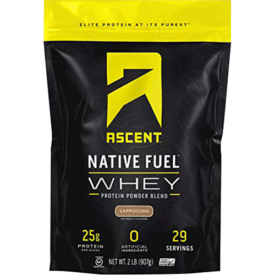
This naturally-sweetened whey protein powder tastes remarkably good with water. Ascent also utilizes an unusual filtration process to create their Native Whey Isolate Blend by removing one step of typical whey protein processing.
Ascent Whey Protein Review
Check out BarBend’s full video review of the formerly titled Ascent Native Fuel Whey Protein Powder.
Main Takeaways
- The 25 grams of whey protein per serving hits the top of the typical range we see among protein powders — 20 to 25 grams.
- All the flavors we tried earned high marks — our testers even enjoyed them when only mixed with water.
- People with sensitivities to lactose or soy should be aware that it contains both.
Ascent Whey Protein Specs
| Price Per Serving | Starting at $1.39 |
| Serving Size | 33g |
| Type of Protein | Whey protein isolate blend |
| Protein Content | 25g |
| Carb Content | 4g |
| Notable Ingredients | 5.5g BCAA, 2.6g leucine, stevia leaf extract |
| Flavors | Chocolate, Vanilla Bean, Chocolate Peanut Butter, Mint Chocolate Chip, Lemon Sorbet, Mocha Cold Brew, Unflavored |
| Third Party Testing | Certified Gluten Free, Informed Sport Certified |
With just 4 grams of carbs and a single gram of fat, Ascent Whey is a straightforward and tasty protein powder. How do we know? Three members of the BarBend team (including yours truly) tried out three different flavors, plus our expert reviewer and registered dietitian nutritionist Chelsea Rae Bourgeois analyzed the formulation. “Ascent Native Fuel Whey Protein is a lean protein powder, ideal for those who need a boost of protein without skewing their other macronutrients,” she says.
When it comes to building muscle, BCAAs (branched-chain amino acids) have a big role to play — especially leucine. Studies have shown that this particular amino acid is closely associated with muscle protein synthesis, so we love that it’s such an important part of Ascent’s formula. Many elements go into gaining muscle, but research suggests the BCAA content here can help kick-start muscle protein synthesis. (1)(2)
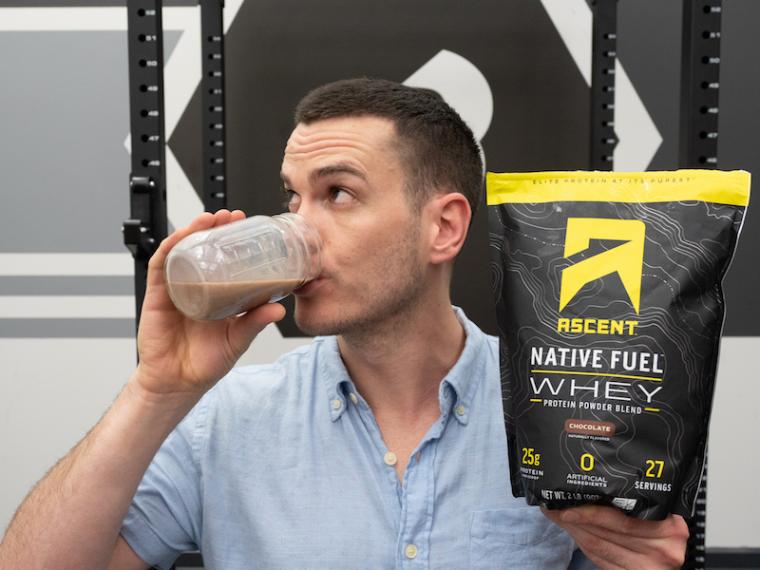
Not only were the Chocolate, Vanilla Bean, and Lemon Sorbet flavors wins for us, but we were all impressed by the simplicity of the formula — even among the best whey protein powders. With several bulk options available, one bag — maybe the 4-pound variety — could be used by multiple members of one household, like in the case of certified personal trainer Kate Meier. “We have each used this about three times a week,” she says of her family. “It’s absolutely delicious and I’m sure we’ll be fighting for the last scoop!”
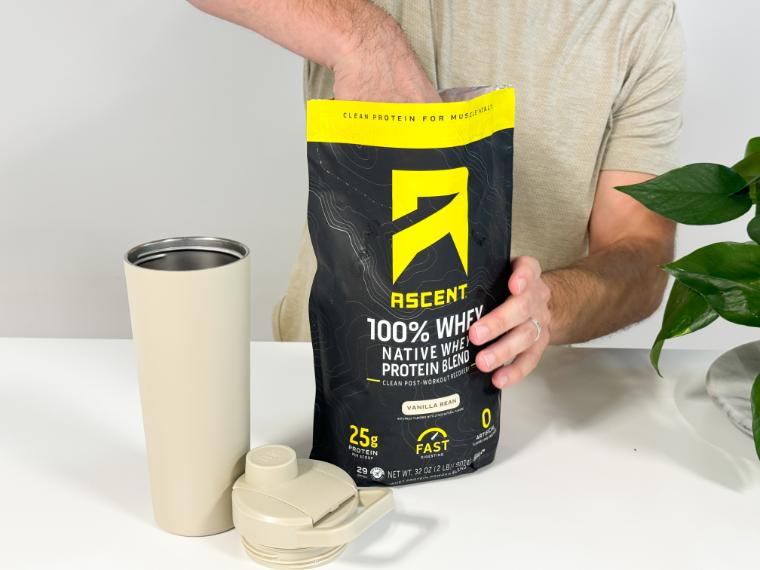
After talking to a scientist from Ascent, we also learned that their whey protein is uniquely formulated in their own facility — notable in its own right. Their Native Whey Protein Blend is a mixture of different types of protein (their Native blend, plus standard whey concentrate and whey isolate), but their isolate is slightly less processed than typical powders. We’ll dive into more detail below, but overall, Ascent Whey Protein’s clean formula and appetizing flavors earned high marks from all four of us.
Who Should Use / Who Shouldn’t Use Ascent Whey Protein
With a higher-than-average amount of protein and BCAAs, Ascent Whey Protein could be a good fit for a lot of people. Others, not so much. Take a look at who we think should and shouldn’t use this powder.
Recommended for:
- Those who want a formula featuring BCAAs (especially leucine) to kick-start muscle protein synthesis (1)(2)
- Competitive athletes who need to make sure their supplements contain no banned substances
- Anyone looking to mix their protein powder with water without sacrificing taste
Not Recommended for:
- Someone trying to supplement their micronutrients and protein in one product
- Users with sensitive stomachs who prefer a protein powder with digestive enzymes
- People sensitive to lactose
Our Experience Using Ascent Whey Protein
The three members of the team who scooped, mixed, and guzzled down Ascent Whey Protein all agree — this stuff is good. Its supreme solubility and taste are big pros, but BarBend expert reviewer Chelsea Rae Bourgeois, a registered dietitian nutritionist, also likes what’s under the hood. Over the years, the BarBend team of certified nutrition coaches, personal trainers, and competitive lifters have tried over 130 protein powders. For each one, we’ve assigned ratings of 1 (lowest) to 5 (highest) across categories like formulation, taste, value, and more.
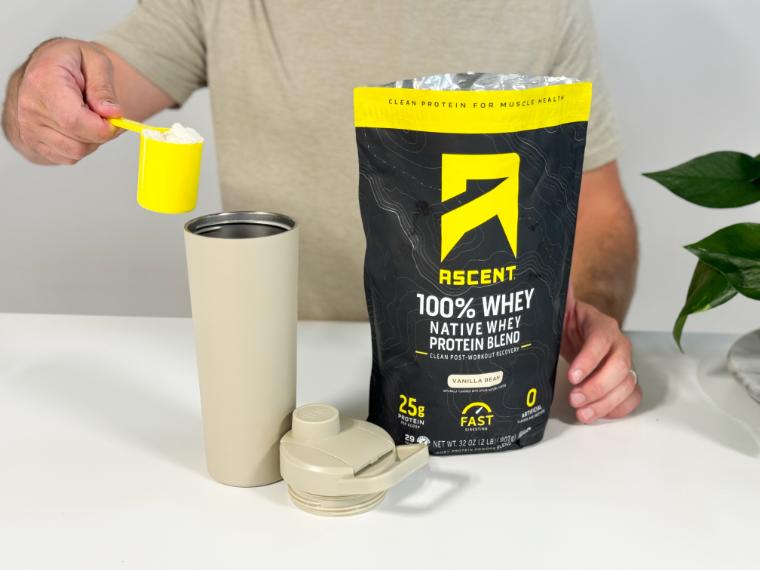
Our team is quite well-versed in protein powder’s benefits and we think Ascent Whey Protein is a match for people who are set with their micronutrients, but might be low in, well, protein. All three of us were also surprised how good it tasted when mixed in water. Read on to discover what else we learned in our time with this protein powder.
What is “Native” Whey Protein Isolate?
Before we get to Ascent’s Native Whey Protein Isolate, a quick primer about whey concentrate and whey isolate proteins. “Their differences start in production,” says our expert reviewer, Chelsea Rae Bourgeois. “Concentrate undergoes the least amount of processing.” Whey concentrate contains more fat and carbs than whey isolate, and anywhere from 30% to 90% of the calories come from protein.
“Whey Isolate undergoes some more processing, so they take out some of the fat and some of the lactose,” Bourgeois adds. “You’re going to be left with a higher-concentrated protein powder — around 90% protein.”
[Related: Best Dairy-Free Protein Powders]
On the label, the first ingredient listed is “Whey Protein Isolate Blend.” So…a blend of what? In short, this blend is a mix of typical whey protein isolate and Ascent’s Native Whey Protein Isolate. That blend is then combined with whey protein concentrate to comprise the entire 25 gram protein content.
After speaking to one of the scientists at Ascent, I learned that Native Whey Isolate isn’t sourced from the cheesemaking process. Instead, their process involves lifting the whey isolate right out of the milk through an unusual type of filtration process. Rather than use the typical two-step process — separating casein and whey, then processing the whey — there’s just one step, allowing Ascent to claim that it is “less processed.”
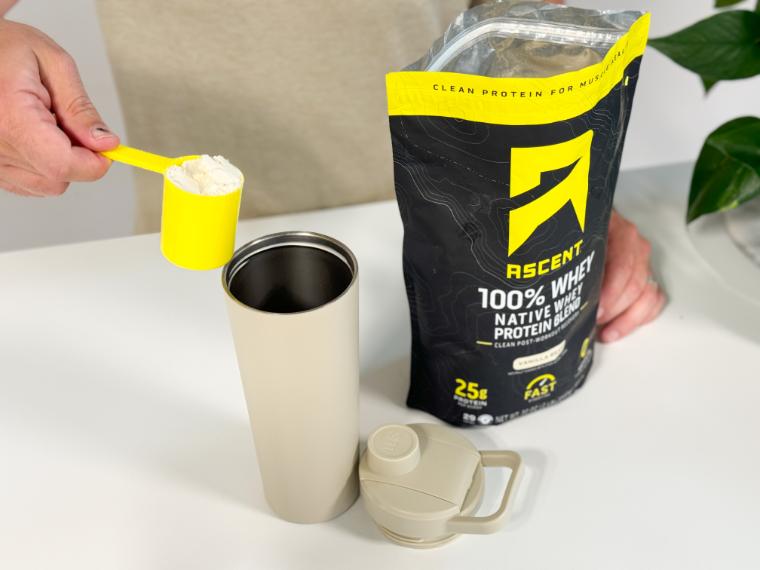
That sounds good, but when I asked about the practical difference between their method and the standard separation process, they said it may not actually be a major one. It’s simply less processed.
Ingredients and Formulation
“I’m really impressed with the simplicity of this protein powder’s ingredient list and its lean nutrition facts,” says our expert reviewer and registered dietitian nutritionist Chelsea Rae Bourgeois, who scored its formulation 4.5 out of 5. “It’s ideal for those who like to prioritize whole foods in their diet and rely on supplements to bridge any nutritional gaps.”
After the whey, all that’s left are natural flavors, soy lecithin (for mixability), sea salt, and stevia leaf extract, Ascent’s natural sweetener. While the lack of added sugars, artificial flavors, and sweeteners is a plus, anyone sensitive to soy should be aware of its use of soy lecithin. It’s also worth noting for those with sensitive stomachs that there are also no digestive enzymes. These types of enzymes can help minimize digestive discomfort and enhance absorption. (3)(4)(5)
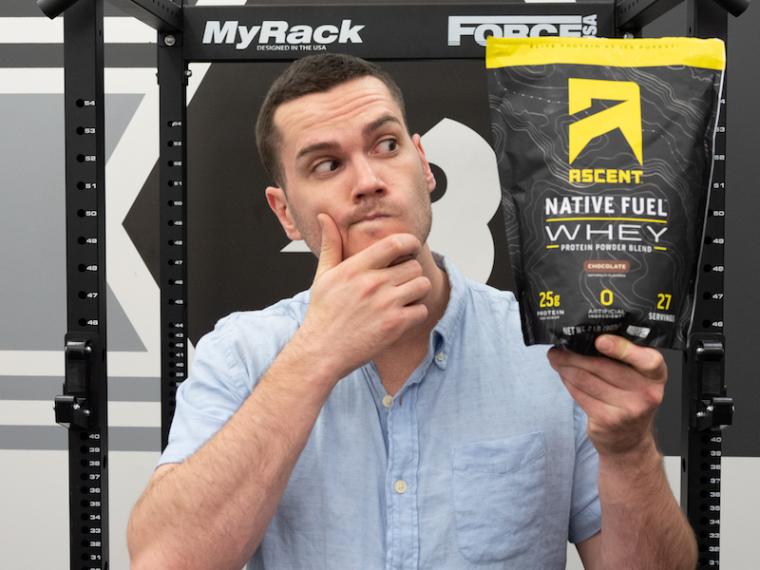
“Because its ingredient list is so minimal, the whey protein powder‘s vitamin and mineral profile is slightly limited,” Bourgeois points out. In each rounded scoop you will gain small amounts of a few micronutrients — 10% of your daily value of calcium (138 milligrams) and 6% of both iron (1 milligram) and potassium (244 milligrams). Each serving also provides 10% of the recommended daily amount of cholesterol (30 milligrams). With less than a gram of dietary fiber, though, don’t expect to feel too full.
Because Ascent Whey Protein’s ingredients are limited, Bourgeois emphasizes that it won’t be a good source of these micronutrients. “I love the simplicity of this protein powder. It’s a great option for those who eat a well-balanced diet but tend to fall short of their protein needs.” She adds that not relying on a protein supplement to get your vitamins and minerals can actually encourage users to prioritize whole foods instead.
How Important is Leucine?
Ascent also places a big emphasis on their BCAA (branched-chain amino acids) count, particularly leucine. There are a few reasons that extra leucine might be important. Several studies suggest that leucine may be the amino acid most closely associated with muscle protein synthesis, a process that switches on genes responsible for muscle gain. (1)(2)
This is why you’ll see that many of the best protein powders for weight gain include BCAAs. Of course, there’s much more to muscle gain than leucine — like workouts, sleep, calorie intake, and overall diet — but muscle protein synthesis may be an important piece of the puzzle. (1)(2)
Taste
When it comes to taste, certified personal trainer Kate Meier and I both rated Ascent’s Chocolate flavor 5 out of 5. “The Chocolate is simply fantastic,” says Meier, who tried it with both milk and water. “Even just mixed with water, it’s somehow still creamy. This is sweetened with stevia, but I couldn’t detect that at all.”
I also mixed up the Chocolate variety with 2% milk and water, and was similarly impressed by how delicious it was with water. Forgive us for geeking out over the water, but trust us, it’s rare for a naturally sweetened protein powder to be this good in water alone. It’s sweet without being overwhelming and it even manages to confer an ever so slightly creamy taste despite having just 1 gram of fat per serving.
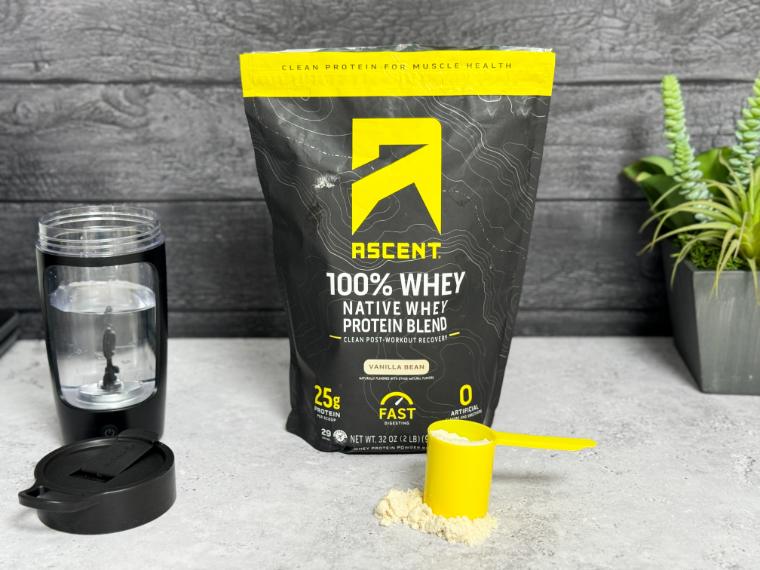
I was hesitant about trying Ascent’s signature Lemon Sorbet flavor — a citrus flavor with the dairy base of whey? I stuck with water and was again pleasantly surprised. Instead of the sour notes I was expecting, it reminded me of the milk left over from a bowl of Froot Loops. It was sweet, mild, and totally unique among any other whey flavors I’ve tried.
BarBend editorial member Matt Cummings also thought the Vanilla Bean flavor was one of the best-tasting protein powders he’s tried in just water. “The taste when mixed with water was just as good as it was with milk, which is shocking,” he says, scoring that option 5 out of 5. “Of course, the fat in the milk made it taste a little better, but I usually don’t want to just down a whole glass of milk — especially when this is just as good in water.”
Solubility
Many protein powders — including Ascent Whey Protein — contain soy lecithin to help achieve a smoother consistency. Cummings separately used a traditional shaker cup, then an electric mixer to see how well this powder dissolved in each. “I’d say using the electric mixer made for a marginally smoother mix, but both methods were great,” he says. “The only difference was there was a tiny bit stuck to the sides of the shaker cup, but none in the electric mixer.”
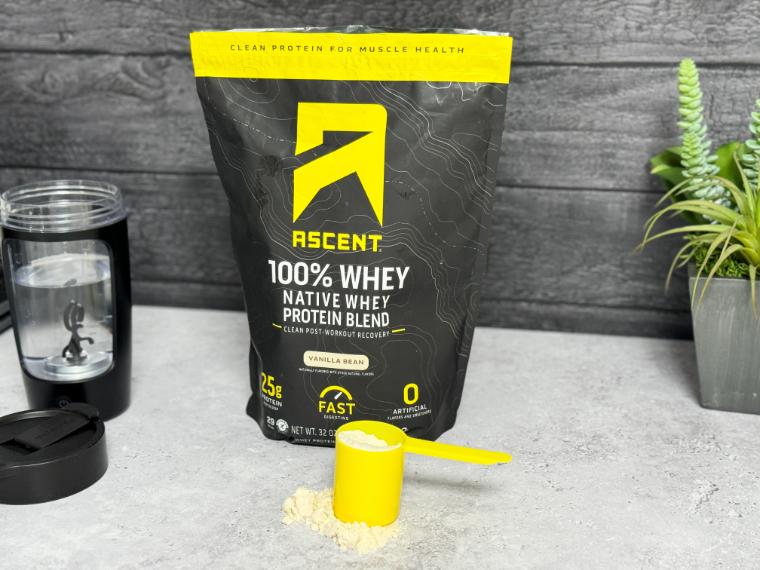
Meier also went with a blender cup when she tried it out. “No issues at all even in just a cup and zero clumps at the bottom,” she says. Just like its taste, all three of us scored solubility 5 out of 5.
Price Per Serving
Ascent offers four ways to purchase their whey protein, and the more you buy, the more you’ll save. Compared to most whey protein powders we’ve tried, most of these options fall within the average range of roughly $1.50 to $2 per serving. As a whole, it earned a 3.75 out of 5 from our team for price per serving.
| Price | Servings Per Container | Price Per Serving | |
| 1lb bag | $24.99 | 14 | $1.79 |
| 2lb bag | $44.99 | 27 | $1.67 |
| 4lb bag | $74.99 | 54 | $1.39 |
| 15 individual packets | $39.99 | 15 | $2.67 |
If you opt for the Subscribe & Save option, you’ll get free shipping on your regular deliveries, as well as 10% off all orders. Any purchase over $79 also earns free shipping.
Third Party Testing
Ascent Whey Protein is Certified Gluten Free and Informed Sport Certified, which means it has been third-party tested for banned substances. We scored this testing 5 out of 5 because it can give competitive athletes peace of mind before competitions, as well as provide a layer of transparency for all customers.
What to Consider Before Buying Ascent Whey Protein
Before signing up for a subscription or committing to a hefty container, there are a few factors to consider. Think about how Ascent Whey Protein aligns with your dietary needs and restrictions, as well as your budget.
- Protein Type: The whey protein in Ascent’s whey protein blend is derived from dairy products, so keep that in mind if you are sensitive to lactose or have a dairy allergy. Their unique filtration process removes one step of typical whey isolate formulation — if the idea of a less-processed protein source is important to you, that’s a point in favor of Ascent.
- Protein Content: The 25 grams of protein in Ascent hits the top of the average range — 20 to 25 grams — we see among protein powders. The general recommendation for daily protein consumption is 0.8 grams per kilogram of bodyweight, so think about just how much you’ll need to supplement your diet. (6)
- Price Per Serving: Ascent is available in four different amounts — 1, 2, and 4 pounds, or individual packets — and the price ranges from $1.39 and $2.67 per serving. Buying in bulk can save a decent chunk of change, so think about whether you just want to try it out if you’re in it for the long haul.
- Third-Party Testing: Ascent Whey Protein is Certified Gluten Free, so those with gluten sensitivities or allergies can rest assured. Competitive athletes may be glad to see that it has also been certified by Informed Choice, which tests for over 250 common banned substances.
Ascent Whey Protein Vs. Competitors
Transparent Labs Whey Protein Powder and Xwerks Grow are two of our highest-rated whey protein isolate powders, so these are heavy-hitting comps for Ascent Whey Protein. Let’s see how Ascent Whey Protein stacks up against these two quality powders.
| Ascent Whey Protein | Transparent Labs 100% Grass-Fed Whey Protein Isolate | Xwerks Grow | |
| Price per Serving | $1.39 to $2.67 | $2 | $1.96 |
| Serving Size | 33g | 34.9g | 30g |
| Type of Protein | Whey protein isolate blend | Whey protein isolate | Whey protein isolate |
| Protein Content | 25g | 28g | 23-25g |
| Carb Content | 4g | 1g | 1-2g |
| Notable Ingredients | 5.5g BCAAs, 2.6g Leucine, Stevia leaf extract | Stevia leaf extract, all nine essential amino acids | 6g BCAAs, Stevia leaf extract |
| Flavors | Chocolate, Vanilla Bean, Chocolate Peanut Butter, Mint Chocolate Chip, Lemon Sorbet, Mocha Cold Brew, Unflavored | Milk Chocolate, French Vanilla, Chocolate Peanut Butter, Mint Chocolate Chip, Vanilla Peanut Butter, Strawberry Milkshake, Unflavored, Dark Chocolate, Oatmeal Chocolate Chip Cookie, Cinnamon French Toast, Sugar Cookie, Mocha, Peanut Butter, Vanilla Oatmeal Cookie, Blueberry Pancakes | Chocolate, Peanut Butter, Strawberry, Vanilla |
| Third Party Testing | Certified Gluten Free, Informed Sport Certified | Informed Protein, Informed Choice | N/A |
First off, depending on the container size you go with, you can save up to roughly 30% per serving with Ascent. Its protein content aligns with Xwerks Grow, but you’ll gain an extra 3 grams with Transparent Labs.
While Ascent and Xwerks list just their BCAA content, Transparent Labs includes all nine essential amino acids, including branched-chain amino acids. All three use the natural, zero-calorie sweetener stevia leaf extract to avoid artificial sweeteners like sucralose or acesulfame potassium.
[Related: Best BCAA Supplements]
Transparent Labs’ nine available flavors edge out the seven from Ascent and four from Xwerks Grow. Among the flavors we personally tried, though, all three of these protein powders earned taste scores of 5 out of 5. We’ll call it a draw.
Their formulas are also highly rated by our expert reviewer Chelsea Rae Bourgeois. However, whereas Ascent Whey Protein and Transparent Labs Whey Protein Powder boast third-party testing, Xwerks makes no mention of independent testing of their formulation.
Places to Buy Ascent Whey Protein
You can buy Ascent Whey Protein from their website, on Amazon, and through major retailers like Walmart.
Customer Experience and Brand Reputation
Unlike other protein powder manufacturers, Ascent places a greater emphasis on performance and athletics as opposed to weight loss. Ascent Whey Protein is one of the best clean protein powders we’ve used and we appreciate that they actually own the facility where their protein is made.
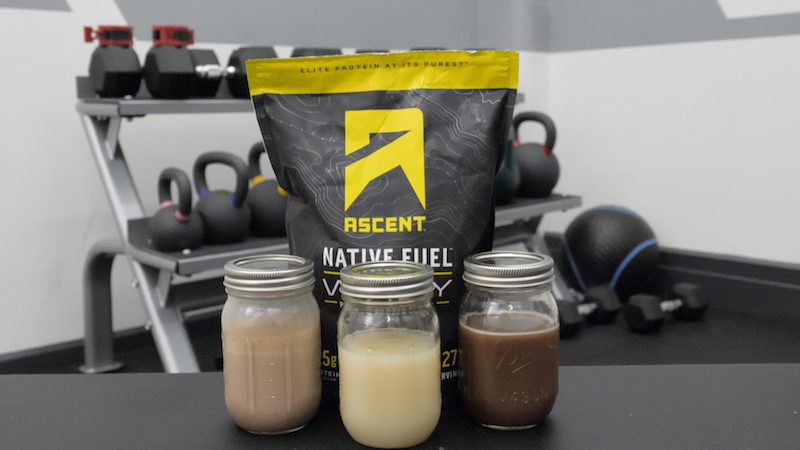
When you order from ascentprotein.com, you’ll earn free shipping on all subscription orders or anything over $79. Since many of their products are also available on Amazon, some are eligible for Prime shipping with a membership. After reviewing thousands of reviews on Amazon, its average score is 4.7 out of 5. Like us, customers highlight its taste, solubility, and solid protein content.
Our Final Verdict on Ascent Whey Protein
While its Native Whey Protein Blend still contains standard whey isolate and whey concentrate, part of that mix is Ascent’s specially-processed whey protein. If reduced processing, appealing flavors, and natural sweeteners sound appealing, this could slide into your diet rather smoothly. Its straightforward formulation earned high marks from our expert reviewer, a registered dietitian nutritionist.
The biggest surprise among our team members was just how delicious it tasted when mixed with water alone. Its vitamin and mineral content is somewhat low, but we appreciate that Ascent Whey Protein stays in its lane. If you’re looking for a supplement geared toward filling a protein gap in your diet while offering BCAAs, our team agrees that this powder warrants a closer look.
Ascent Whey Protein FAQs
Is Ascent Whey Protein lactose-free?
Ascent Whey Protein contains less than a gram of lactose, but its high-quality whey protein is derived from milk. If you’re looking for a lactose-free option, many of the best dairy-free protein powders use plant-based protein from peas, soy, brown rice, hemp, and more.
Is Ascent Whey Protein good?
Multiple members tag-teamed Ascent’s testing to sample three flavors — Chocolate, Vanilla Bean, and Lemon Sorbet. All three great-tasting options earned ratings of 5 out of 5, plus another 5 out of 5 for solubility.
What are the benefits of Ascent Whey Protein?
Along with its relatively high protein content (25 grams per serving), Ascent Whey Protein contains no artificial ingredients, is Gluten-Free Certified, and has been tested by Informed Sport Choice.
Should I use Ascent Whey Protein post-workout?
Ascent recommends consuming their whey protein shake 30 to 40 minutes after completing a workout to assist with recovery.
References
- Norton, L. E., & Layman, D. K. (2006). Leucine regulates translation initiation of protein synthesis in skeletal muscle after exercise. The Journal of nutrition, 136(2), 533S–537S.
- Breen, L., & Churchward-Venne, T. A. (2012). Leucine: a nutrient ‘trigger’ for muscle anabolism, but what more?. The Journal of physiology, 590(9), 2065–2066.
- Oben, J., Kothari, S. C., & Anderson, M. L. (2008). An open label study to determine the effects of an oral proteolytic enzyme system on whey protein concentrate metabolism in healthy males. Journal of the International Society of Sports Nutrition, 5, 10.
- Muss, C., Mosgoeller, W., & Endler, T. (2013). Papaya preparation (Caricol®) in digestive disorders. Neuroendocrinology letters, 34(1), 38–46.
- Zhou, Z., Wang, L., Feng, P., Yin, L., Wang, C., Zhi, S., Dong, J., Wang, J., Lin, Y., Chen, D., Xiong, Y., & Peng, J. (2017). Inhibition of Epithelial TNF-α Receptors by Purified Fruit Bromelain Ameliorates Intestinal Inflammation and Barrier Dysfunction in Colitis. Frontiers in immunology, 8, 1468.
- Ellinger, S., Amini, A. M., Haardt, J., Lehmann, A., Schmidt, A., Bischoff-Ferrari, H. A., Buyken, A. E., Kroke, A., Kühn, T., Louis, S., Lorkowski, S., Nimptsch, K., Schulze, M. B., Schwingshackl, L., Siener, R., Stangl, G. I., Volkert, D., Zittermann, A., Watzl, B., Egert, S., German Nutrition Society (2024). Protein intake and body weight, fat mass and waist circumference: an umbrella review of systematic reviews for the evidence-based guideline on protein intake of the German Nutrition Society. European journal of nutrition, 63(1), 3–32.